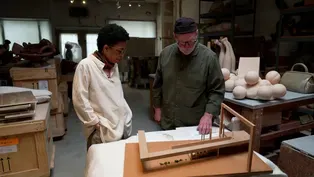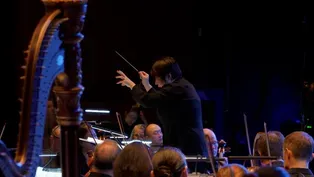State of the Arts
Deborah Jack: The Duality of Nature
Clip: Season 43 Episode 7 | 8m 28sVideo has Closed Captions
Deborah Jack's alluring video installations explore coastlines affected by climate change.
Deborah Jack blends film and poetry in immersive video installations that explore the eroding coastlines of St. Maarten and New Orleans. State of the Arts joins her on location in Louisiana and in her Jersey City studio to see how Deborah translates the science of climate change into powerful visual narratives.
Problems with Closed Captions? Closed Captioning Feedback
Problems with Closed Captions? Closed Captioning Feedback
State of the Arts is a local public television program presented by NJ PBS
State of the Arts
Deborah Jack: The Duality of Nature
Clip: Season 43 Episode 7 | 8m 28sVideo has Closed Captions
Deborah Jack blends film and poetry in immersive video installations that explore the eroding coastlines of St. Maarten and New Orleans. State of the Arts joins her on location in Louisiana and in her Jersey City studio to see how Deborah translates the science of climate change into powerful visual narratives.
Problems with Closed Captions? Closed Captioning Feedback
How to Watch State of the Arts
State of the Arts is available to stream on pbs.org and the free PBS App, available on iPhone, Apple TV, Android TV, Android smartphones, Amazon Fire TV, Amazon Fire Tablet, Roku, Samsung Smart TV, and Vizio.
Providing Support for PBS.org
Learn Moreabout PBS online sponsorship[ Music plays ] [ Music plays ] Jack: The coastline for me has always functioned conceptually as a site of arrival and departure, salt water and seawater.
thinking of salt as a material that corrodes and preserves.
I'm always interested in sort of the duality that nature presents.
Whenever I'm around the coastline, I film.
I'm always sort of, like, gathering images of the edges and thinking about what happens when that water goes past that line.
Sea-level rise is impacting lands throughout the world.
There's micro erosions that are happening.
What does that shift for all of us?
[ Music plays ] So, the last part of the chapter is...
Currently, I'm a professor of art at New Jersey City University.
Working as an artist, and I think, also, with young artists also keeps me kind of like perpetually a student and always wanting to know and just being curious.
[ Music plays ] I made two trips down to Louisiana.
To me, New Orleans served, really, as an interesting site to project from.
[ "When the Saints Go Marching In" plays ] It's a very vibrant community.
It's fertile ground for imagination, I think, here.
Like, just driving down the street, you see so many people are engaged with so many different ideas.
[ Music plays ] So, the work I have in Prospect.6 at the UNO Gallery, "A Sea Desalts," is a six-channel video installation with sound, as well as nine still images, and text.
[ Music plays ] Prospect came to me because they knew my work was already dealing with issues around climate change.
Lash: Prospect is an international art triennial.
It's the longest one of its kind in the U.S., in that it's made of 21 venues, all around the city of New Orleans -- everything from art museums to art on the shores of the Mississippi.
Each cycle, we welcome many hundreds of thousands of people to the city of New Orleans in celebration of art.
The theme of this year's iteration is "The Future is Present, the Harbinger is Home."
New Orleans is living in close proximity to climate change.
A harbinger people think of as a threat, right -- something that's looming, in the future.
But we love how the origins of this word hold the word "harbor," to prepare a space for others.
It is the one that has to go forward in advance.
[ Music plays ] Deborah Jack's piece brings together the cost of human intervention, with footage from Sint Maarten, Maine, and New Orleans, and shows a sense of interconnectedness, which is absolutely the key to our collective survival.
[ Music plays ] [ Waves crashing ] Jack: Where the river and the sea meet is where they each cease to be.
In between intertwining wetlands, in reverent making and unmaking.
[ Music plays ] [ Music plays ] The whole idea of "A Sea Desalts" had to do with sort of, you know, the melting of the polar ice caps was leading to sort of, like, sea-level rise as the planet gets warmer.
Hurricanes function almost like as a natural sort of, like, cooler to the planet.
And so the warmer the planet, the more the hurricanes sort of increase.
[ Thunder rumbles ] Kolker: We took Deborah to an area called Neptune Pass, which is an area that we've been studying, looking at various river systems or various wetlands and marshes and how they're changing.
And so we helped collect some of the video that's in her installation.
I love seeing the natural world in action.
Deborah's installation does a very powerful job of showing that sea-level rise and coastal change is something that people all across the world should be thinking about.
I thought it was really thought-provoking to see that in combination with scenes from other places.
Louisiana, in many ways, is one of the first areas to experience extreme weather from climate change.
The kinds of things that we experience here are the kinds of things that people all over the world, including places like New Jersey, will experience in the years ahead.
As a scientist and as an educator, I try to do everything I can to help people relate to the natural world.
But there's also a role for the arts to reach people in a way that science can't reach people.
And I think that there's a real role for artists like Deborah Jack and others to communicate the story of our changing planet.
[ Music plays ] Jack: The science is there, but it's like how do we feel living in these spaces?
[ Music plays ] Growing up in Sint Maarten and the Caribbean, having gone through several hurricanes in my lifetime, I think it lingers.
It resonates more.
[ Waves howling ] I remember going through Hurricane Luis in '95 and really not dealing with it, and then not until Hurricane Katrina hit in 2005, sort of, like, watching that devastation.
That's when I had an emotional response to what had happened to me.
[ Music plays ] There's a moment when people are interviewing someone who's lost everything and lost their house.
And that moment, that look in their eye, is one that always will tear me up.
[ Music plays ] So I think art is a really powerful tool.
I'm drawn to trying to think about pulling out sort of like feelings, because I think that's the human part.
That's where we connect to things.
Even though I work with a variety of media, filming something is probably my default.
As a kid in Sint Maarten, I was always interested in that, like, rectangle and what could happen in that space.
There's a sort of experiential component to the moving image, and in my case, to, also, then, the multiple screens.
[ Music plays ] Editing a multi-screened installation is always challenging.
A lot of times, it's about thinking about these screens or having a conversation with each other, conversating and having a negotiation, so to speak, visually.
Having multiple screens forces you to be a bit more active.
You have to move through the space, sort of forced to sit with it and sometimes look at it more than once.
When I'm making work like this, it's always, you know, tricky.
I try not to be didactic.
I'm not trying to preach.
And I think I want people to feel a sense of something.
Because the world is changing, the emotions are also changing.
As we make work about climate change, it can always feel very doom.
Dr. Alex Kolker told me about how Neptune Past had gone from about a 175-foot waterway, expanding into like 800 feet wide.
Here I come, thinking about land loss, and here was nature building land.
I'm trying to be more and more careful in terms of, like, having hope in the work, not sort of like a frivolous sense of hope, but, also, just thinking that, yes, there is, also, this opposite, that nature takes, but it also provides.
I want the people who come to see my work to at least come away compelled to sort of, like, ask some questions about the landscape that they're in.
I think when land is so vast like it is here in the U.S., the minute you're, like, in a more inland area, it's easy to forget, like, what are the edges really about?
What is happening at your edges?
Batsto Homestead: Connecting to the Pine Barrens at Rowan University
Video has Closed Captions
Art by Syd Carpenter and Jack Larimore evokes the Pinelands in Rowan's new Student Center. (6m 16s)
Video has Closed Captions
Nimbus Dance and New Jersey Symphony reimagine Stravinsky’s Firebird for today's world. (9m 25s)
Providing Support for PBS.org
Learn Moreabout PBS online sponsorshipSupport for PBS provided by:
State of the Arts is a local public television program presented by NJ PBS













